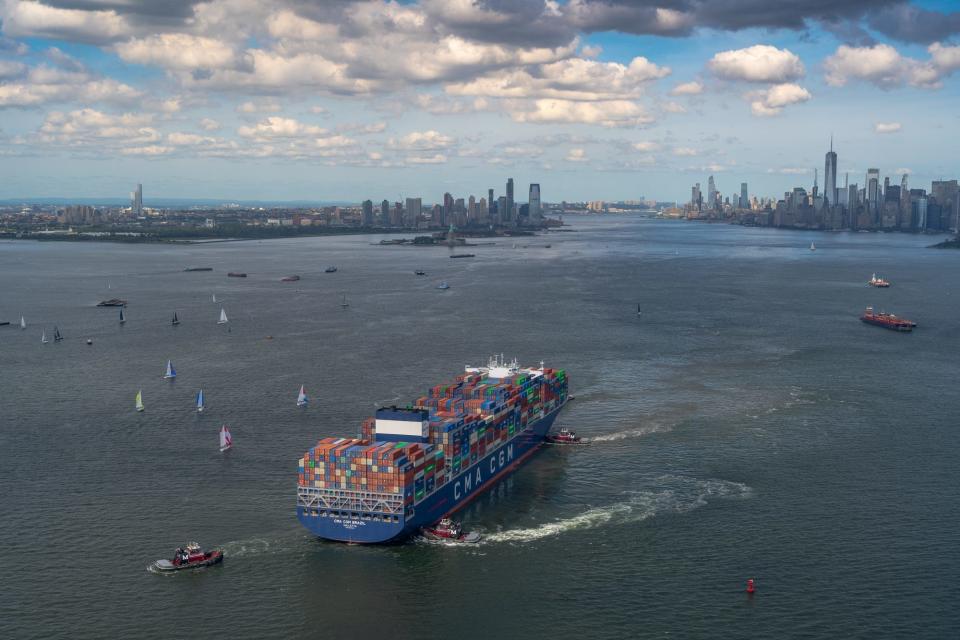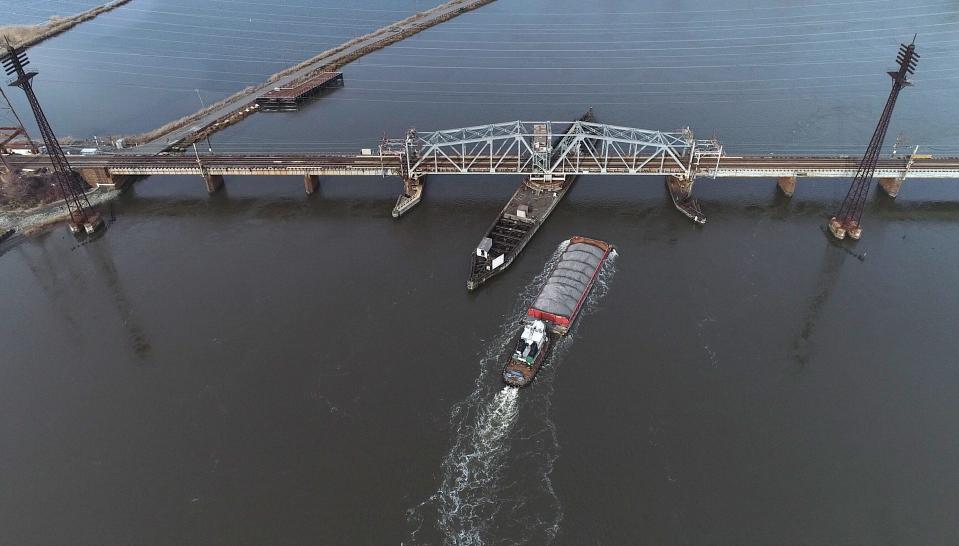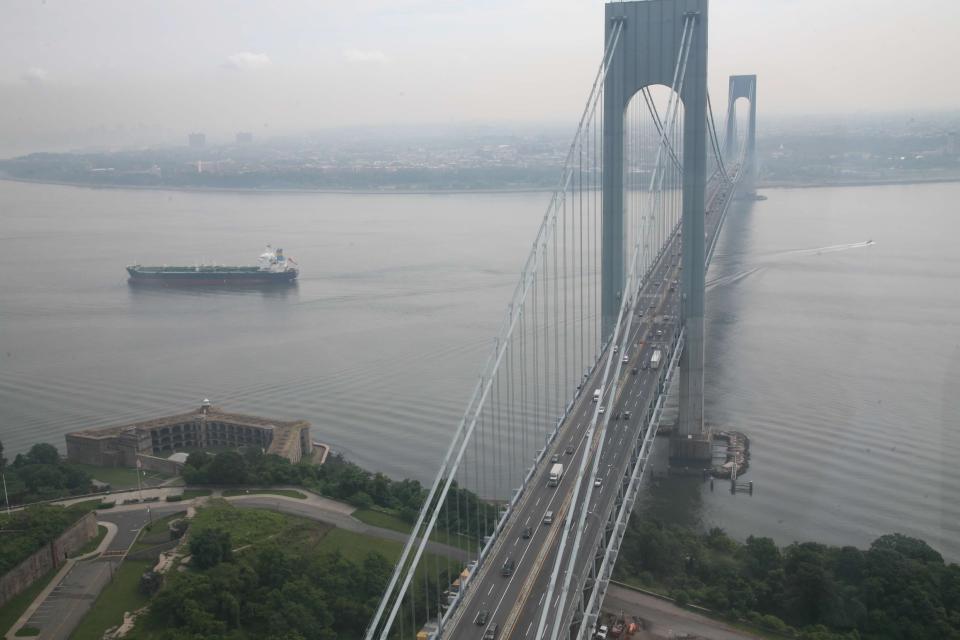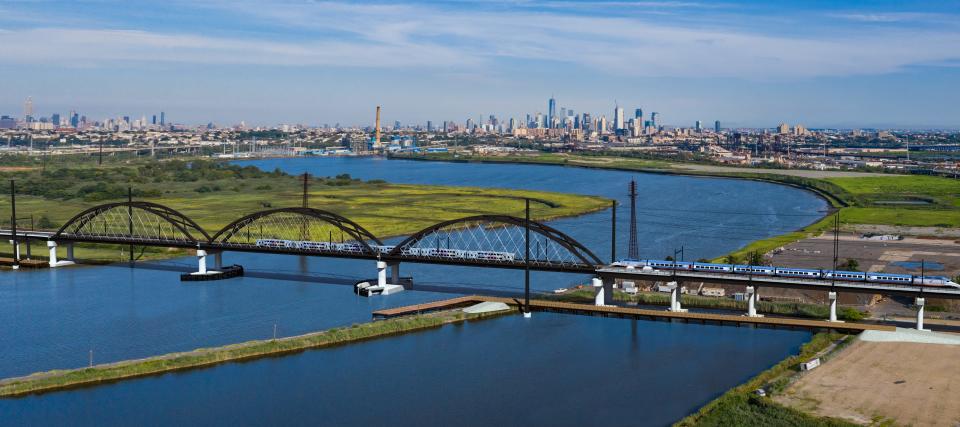Here's how Port of NY and NJ bridges are protected from cargo ship collisions
The devastating sight of the Francis Scott Key Bridge collapsing into the Patapsco River in Baltimore after a cargo ship struck it in the early hours of Tuesday morning raises questions about whether such an event could happen in the Port of New York and New Jersey, the busiest on the East Coast.
In fact, the Dali — the Singapore-flagged ship that lost power before striking the Key Bridge — made its way through the waters that separate New York and New Jersey just days earlier. It passed under the Bayonne Bridge and the Verrazzano-Narrows Bridge on March 19 and 21 before and after stopping at APM Terminals at Port Elizabeth in Newark Bay.
When the Dali entered the Port of New York and New Jersey, it was guided by at least four tugboats and assisted with at least two on-ship local pilots.
When it left Baltimore, it was guided by tugs briefly but was on its own once it entered more open water as it approached the Key Bridge.
Story continues below photo gallery.
Tugboats play a big role in helping large ships maneuver when forced to slow down in New York Harbor, where they have to make sharp turns to get through the Kill Van Kull between Staten Island and Bayonne, and then make a right turn after passing beneath the Bayonne Bridge into Newark Bay, said Capt. Morgan McManus, who trains students at SUNY Maritime College in the Bronx.
"The big difference is the physical structure of the port itself," McManus said. "So you get out of Baltimore Harbor — there, you come out to a fairly wide, straight channel that’s on the center of that bridge span and then exit out to the upper part of the Chesapeake Bay," McManus said.
"When you look at the vessel track, it’s a pretty standard departure. The ship came off the docks, it made its U-turn around, it was shaped up in the channel, and it started increasing speed for maneuvering," McManus said. "Tugs aren’t going to be alongside you at that point."
"If they got a liner from the tug, could it have helped? I don’t know," he said. "You've got a 100,000-ton ship moving at 8 knots. The tug would have to do something called an indirect maneuver to change the direction of a ship and pull on the line to slow the ship down."

He added that the tugs and the pilots who board the ships entering the New York Harbor help them when they are forced to slow down because of the turns and other navigational challenges unique to this region.
"The slower a ship is going, the harder it is to turn the ship, because you don’t have as much water flowing over the rudder, so that’s where the tugs come into play," McManus said.
Even with tugs, NY-NJ water channels are challenging
Even with tugboat assistance, navigating local North Jersey water channels can be challenging.
The Portal Bridge, a rail crossing that spans the Hackensack River and is used by NJ Transit and Amtrak trains around 400 times a day, has been hit a few times in recent years by tugboats guiding barges.

The Portal Bridge swings open for marine traffic but can still get hit, as it did in 2018 and in 2022. Though these were minor incidents, they caused rail traffic to be suspended before the bridge could be inspected and cleared hours later.
"The fender system on one of the channels was damaged, but the bridge structure sustained no damage," Jen Flanagan, a spokeswoman for Amtrak, said about the 2022 incident. "The fender system, which protects the bridge piers, has since been replaced."
More: Your phone, your couch, your clothes: They all arrived in NY Harbor through these dangerous channels
Fenders are one of several methods used to protect bridge infrastructure around the Port of New York and New Jersey.
When the Bayonne Bridge center span was raised 64 feet for a clearance of 215 feet in 2017 — a $1.7 billion project to make way for larger container ships — part of the construction included strengthening the now-93-year-old crossing with reinforced steel and rebar, the Port Authority of New York and New Jersey said.
The bridge piers are outside of the navigational channel, with a fender system protecting them, an agency spokesperson said.

The Verrazzano, which spans the entrance of New York Harbor between Staten Island and Brooklyn, is owned and maintained by the Metropolitan Transportation Authority and has a rock-based protection system around its foundations.
“MTA bridges are equipped with a wide range of safety technology, including ship collision protections," said Catherine Sheridan, president of MTA Bridges and Tunnels.
"The Verrazzano-Narrows Bridge, where the largest ship traffic passes, is a special case in that it has a robust riprap system — a rock island around the tower bases — which would cause a ship to run aground before it could do significant damage to the bridge.”

The Key Bridge in Baltimore, by contrast, had no obvious fender system in place to protect its towers from a ship collision.
New Portal and Raritan bridges will get fenders
Though the Portal and Raritan River bridges don't encounter marine traffic as large as the container ships navigating to and from the ports, defense systems are being built as part of projects to replace both bridges.
"The new Raritan River bridge is designed to resist direct impact from a vessel while sustaining negligible damage to the bridge," said Jim Smith, an NJ Transit spokesman. "A fender system will be installed on the bridge both to offer additional protection to the bridge and to limit damage to vessels if and where they may impact the channel piers."
The Portal Bridge will be replaced by a fixed-span structure and will be raised 50 feet over the Hackensack to avoid having to swing open for marine traffic. It has "been subjected to similar designs, and the bridge-fender system incorporates vessel collision design provisions," Smith said.

Gov. Phil Murphy called the Key Bridge collapse "horrific" at an unrelated news conference Tuesday afternoon.
“It's a frightening situation,” he said, noting that the Portal Bridge is much lower and is a different type of bridge overall but that the “answer has to be yes” when it comes to fortifying bridges for vessel impacts in New Jersey.
Container ships have grown much larger since Key Bridge built
Chris Cerino, a structural engineering director and vice president at STV, a transportation infrastructure firm, said the design and regulation standards of the Key Bridge were consistent with those of the 1970s, when it was built. In the time since, cargo ships that carry shipping containers have become larger to carry bigger and heavier loads.
"Fifty years ago, they didn’t imagine this ship, and we are building infrastructure for longevity and lifespan, so it is hard to defend it against every possible future load," said Cerino, the incoming president of the National Council of Structural Engineers Associations.
Cerino said there often isn't one system or method to defend bridges against strikes.
"Usually the best answer is always the combination of a defense system and operational changes," he said. "We have to really take a look at bridges in these high-traffic areas with very large vessels and see which ones are the most at risk and see how their protections, whether operational or physical, can come into play so this is really prevented in the future."
Staff Writer Katie Sobko contributed to this story.
This article originally appeared on NorthJersey.com: Could Port of NY and NJ bridges collapse from ship strike?

